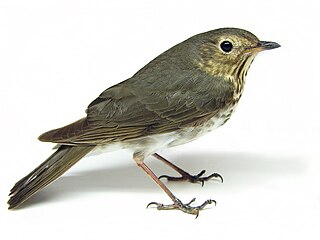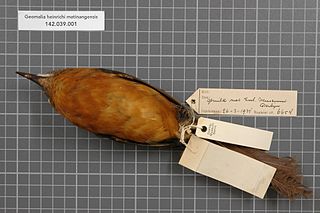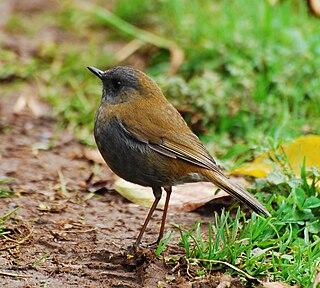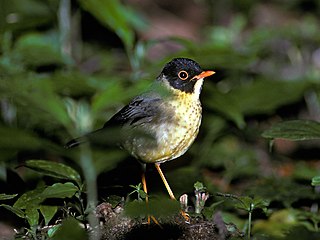
The thrush nightingale, also known as the sprosser, is a small passerine bird that was formerly classed as a member of the thrush family Turdidae, but is now more generally considered to be an Old World flycatcher, Muscicapidae. It, and similar small European species, are often called chats.

The bulbuls are members of a family, Pycnonotidae, of medium-sized passerine songbirds, which also includes greenbuls, brownbuls, leafloves, and bristlebills. The family is distributed across most of Africa and into the Middle East, tropical Asia to Indonesia, and north as far as Japan. A few insular species occur on the tropical islands of the Indian Ocean. There are 166 species in 32 genera. While different species are found in a wide range of habitats, the African species are predominantly found in rainforest, whereas Asian bulbuls are predominantly found in more open areas.

The thrushes are a passerine bird family, Turdidae, with a worldwide distribution. The family was once much larger before biologists reclassified the former subfamily Saxicolinae, which includes the chats and European robins, as Old World flycatchers. Thrushes are small to medium-sized ground living birds that feed on insects, other invertebrates and fruit. Some unrelated species around the world have been named after thrushes due to their similarity to birds in this family.

The genus Catharus is an evolutionary clade of forest-dwelling passerine birds in the family Turdidae (thrushes), commonly known as nightingale-thrushes. The extant species are widely distributed across the Americas and are descended from a common ancestor that lived 4–6 million years ago. Most of the species are shy of humans, seldom leaving the cover of dense forest vegetation, where their activities are hidden from view. Thus, many fundamental aspects of their biology and life histories are poorly known.

The veery is a small North American thrush species, a member of a group of closely related and similar species in the genus Catharus, also including the gray-cheeked thrush, Bicknell's thrush, Swainson's thrush, and hermit thrush. Alternate names for this species include Wilson's thrush and tawny thrush. Up to six subspecies exist, which are grouped into the eastern veery, the western veery or willow thrush, and the Newfoundland veery.

The hermit thrush is a medium-sized North American thrush. It is not very closely related to the other North American migrant species of Catharus, but rather to the Mexican russet nightingale-thrush. The specific name guttatus is Latin for "spotted".

Swainson's thrush, also called olive-backed thrush and russet-backed thrush, is a medium-sized thrush. It is a member of genus Catharus and is typical of it in terms of its subdued coloration and beautiful, ascending flute-like voice. Swainson's thrush was named after William Swainson, an English ornithologist.

The grey-cheeked thrush is a medium-sized thrush. This species is 15–17 cm (5.9–6.7 in) in length, and has the white-dark-white underwing pattern characteristic of Catharus thrushes. It is a member of a close-knit group of migrant species together with the veery and Bicknell's thrush; it forms a cryptic species pair with the latter. The grey-cheeked thrush is all but indistinguishable from Bicknell's thrush except by its slightly larger size and different song. The two were formerly considered conspecific. Of all the American spotted thrushes, the grey-cheeked has the most northern breeding range.

Bicknell's thrush is a medium-sized thrush, at 17.5 cm (6.9 in) and 28 g (0.99 oz). One of North America's rarest and most localized songbirds, it breeds on coniferous mountain tops and disturbed habitats of northeastern North America. While very similar in appearance and vocalization to the gray-cheeked thrush, the two species, with two completely different breeding ranges, differ slightly in their morphology and vocalizations. It was named after Eugene Bicknell, an American amateur ornithologist, who made the first scientific discovery of the species on Slide Mountain in the Catskills in the late 19th century.

The geomalia or Sulawesi mountain thrush is a rare member of the thrush family endemic to Sulawesi in Indonesia. It is sometimes classified as Geomalia heinrichi, in which case it is monotypic in the genus Geomalia.

The black-billed nightingale-thrush is a small thrush endemic to the highlands of Costa Rica and western Panama. Its position in the genus Catharus is somewhat equivocal, but it is apparently closer to the hermit thrush than to the other nightingale-thrushes except the russet nightingale-thrush and/or the ruddy-capped nightingale-thrush.

The ruddy-capped nightingale-thrush is a small thrush which is a resident breeder in mountain forests from central Mexico to western Panama. A predominantly brown-plumaged bird, it has a rich song.

The orange-billed nightingale-thrush is a species of bird in the family Turdidae. It is found in Colombia, Costa Rica, El Salvador, Guatemala, Honduras, Mexico, Nicaragua, Panama, Trinidad and Tobago, and Venezuela. Its natural habitats are subtropical or tropical dry forest, subtropical or tropical moist lowland forest, subtropical or tropical moist montane forest, and heavily degraded former forest.

The yellow-throated nightingale-thrush or Gould's nightingale-thrush is a species of bird in the family Turdidae native to Central America. It was first described in 1855 by English ornithologist John Gould.

The slaty-backed nightingale-thrush is a species of bird in the family Turdidae. It is found in Bolivia, Colombia, Costa Rica, Ecuador, Panama, Peru, and Venezuela.

The black-headed nightingale-thrush is a species of bird in the family Turdidae. It is found in Costa Rica, Guatemala, Honduras, Mexico, Nicaragua, and Panama.

The russet nightingale-thrush is a species of bird in the family Turdidae. It is endemic to Mexico.

The Aztec thrush is a species of bird in the family Turdidae. It is found mainly in Mexico, but vagrants are occasionally seen in the United States. Its natural habitat is montane forests. The IUCN Red List denotes it as a least-concern species.

The forest robin or orange-breasted forest robin is a species of bird from Central and West Africa. It is monotypic in the genus Stiphrornis. It has been placed in the family Turdidae, but is now generally placed in Muscicapidae in the group popularly known as chats. Most taxonomists consider it a single species, but some reviews have recommended recognizing 5 species. It has a total length of around 12 cm, has dark upperparts, and a throat and chest that, depending on the subspecies, is yellow-orange or deep orange.
The spotted nightingale-thrush has been split into the following:



















